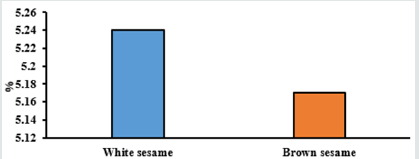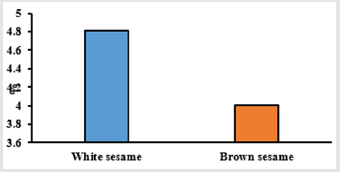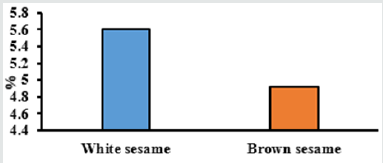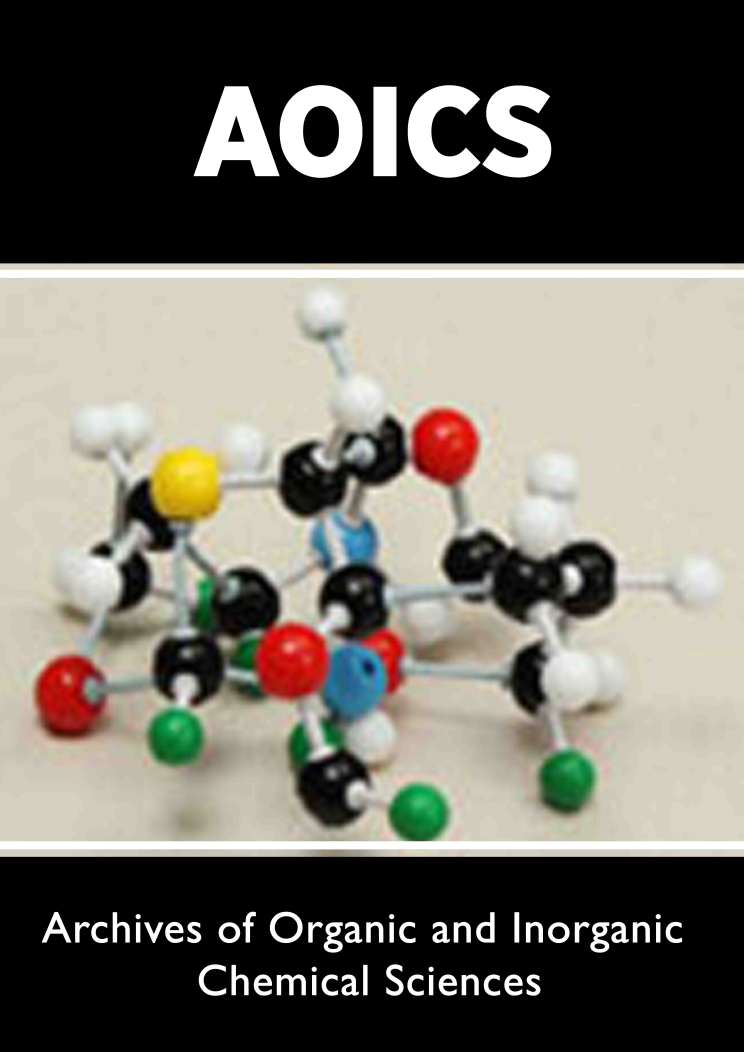
Lupine Publishers Group
Lupine Publishers
Menu
ISSN: 2637-4609
Research Article(ISSN: 2637-4609) 
Proximate Composition of Sudanese Sesamum indicum L. (white and Brown) Sesame seeds Volume 4 - Issue 4
Mahdi Abdelmageed Mohammed Ali, Husham Abdelmonum Mahmoud, Masaged Aldoma and Hatim MY Hamadnalla*
- Department of biology & technology,College of applied sciences; University of Bahri, Sudan
Received: August 12, 2020; Published: August 25, 2020
*Corresponding author: Hatim MY Hamadnalla, Department of biology & technology, College of applied Sciences, University of Bahri, Sudan
DOI: 10.32474/AOICS.2020.04.000195
Abstract
This work deals to study proximate composition of two types of Sesamum indicum (sesame ) seeds white and brown. The objective of this study is to determine the(moisture, Ash, fiber, fat, and protein), the samples were collected from the Sudanese market (Omdurman area) and analyses by method of conduction of proximate composition. The results Showed that there are no different significant and different significant at probability (p<0.05) and it cited that the : (ash =0.027%), (fat= 0.041%), and (crud fiber = 0.008%).The value of moisture considered higher inwhite sesame (5.24±0.07%) than brown sesame (5.17±0.06%), ash value is higher in white sesame (4.81±0.15%) than brown sesame (4.01±0.07%), the crud protein in white sesame and brown sesame are equal (18.95±0.14%), the fat is lower in white sesame (47.09±0.38%)than brown sesame (47.33±0.90%), the crud fiber is lower in white sesame (5.61±0.45%) than brown sesame (4.92±0.25%).
Keywords:Nutritional, Composition, Baobab fruits, Flame photometry and mineral analysis; biochemical composition
Introduction
Sesamumindicum L., known as Sesamum or benni-seed, belong to Pedaliaceae family, the species is one of the most ancient oilseeds crop which plays important role in human nutrition by used the seeds for oil extraction and rest for edible purposes [1]. The plant seeds were primarily used for oil and wine [2].The plant has been grown since the beginning of arable cultivation, and originates from the dry bush savannah of tropical Africa, and spread from there to India and China, where it is still widely cultivated [3].Sesame seeds plays an important for food formulation such as halaweh (sweetened tehinehin human nutrition) [4]. The composition of sesame possesses moisture, proteins, fiber, and ash approximately with respect to 100%gm of seeds, the seed contains 54% oil, 20% protein, 13.4%carbohydrate, 3.2% crude fiber and 3.7% ash [5,6]. The seeds are used for oil extraction and food purposes [7,8]. The oil composition varies depend on climatic condition, oil type, plant maturity and method of processing. Ogunlade [9] The fruit bunch contains on the average 200nuts.the nut has a very thick, hard shell and contains between three to seven seeds, which have high oil content.
The objective of this study
To determine the proximate composition of the two types of sesame seeds (white and brown).
Materials and Methods
The samples of white and brown sesame seeds (Sesamumindicum L.)were collected from a local market in(Omdurman area)
Analytical Methods
All the proximate analyses of ( Moisture, ash, fat, fiber, and protein.) were conducted according to AOAC [10].
Determination of Moisture Content
‘2g of both brown and white seeds were weight and placing
into a pre-weighed aluminum dish and dried in a forced –air
convection oven at 105 ˚C unit a constant weight was reached, the
data reported represents by three determinations for brown and
white as below:
Moisture (%) = ((W2 – W1) – (W3 – W1)) / (W2 – W1) x 100
Where:
W1 = weigh (g) of empty dish
W2= weigh (g) of sample and dish
W3 = Weight of dish and dry sample
Determination of Fat Content
‘3-5 g of samples was placed into bottle that was weighed before
and take it in to Soxhlet, 250 ml of petroleum ether was added and
heated at 80-90°C until solvent is completely evaporate. Then the
bottle was transferred to cool in desiccators after that the bottle
and its dried sample was weighed and calculated as.
Fat (%) = (W2- W1/ W3) x 100
Where:
W1= Weight of empty bottle
W2 = Weight of bottle and oil
W3= Weight of sample
Determination of Fiber Content
‘2g of sample were weighed, 200 ml of sulphuric acid was added
and heated to boiling for 30 minutes and filtered. The residue was
washed three times by using hot water ;100 ml and 50 ml of NaOH
were added and heated to boiling for 30 minutes and filtered,
then washed carefully three times with hot water until it was free
from acid. The sample were dried under suction and transferred to
an oven at 105°C overnight and finally weighed. The residue was
ashed in a muffle furnace at 550°C for three hours till a light grey
ash was formed then weighed to a constant and the total crude fiber
percent was calculated by the equation as below.
Crude fiber (%) = (W1 – W2)/ W3 X 100
Where:
W1 = Weight of sample before ignition
W2 = Weight of sample after ignition
W3 = Original sample weight
Determination of Ash Content
Ash content was determined by drying ash method when empty
crucible was weighed and 2 g of sample was weighed into crucible,
and heated at 550°C in furnace until the sample turns to gray after
complete heating the crucible was placed into desiccators to cool,
and then the sample was weighed again and calculated as below:.
Ash (%) = (W1– W2) / S) x 100
Where:
W1 = Weight of crucible with sample
W2 = Weight of empty crucible
S = Weight of sample
Determination of crude protein
kjeldahl method was used to determine the crude protein. 1g of
sample was placed in digestion flask ; 5 g of kjeldahl catalyst and 200
ml H2SO4 was added and boiled until the solution clears and cooled
, 60 ml H2O was added ;the flask connected to digestion sesame
and immersed in standard acid, 5-7 drops of mixed indicator was
added, and heated until all N2 was distilled after that was titrated
with NaOH and calculated as equation below:
Protein (%) = ((A-B) x N x 14.007 x 6.250) / W
Where
A = Volume (ml) of 0.2 N HCL used sample titration
B = Volume (ml) of 0.2 N HCL used in blank titration
N = Normality of HCL
W = Weigh (g) of sample
14.007 = Atomic weigh of nitrogen
6.25= the protein- nitrogen conversation factor.
Result and Dissection
The result of the present study was done as Table 1 below. From the (Table 1) the moisture content was higher in white sesame (5.24±0.07%) than brown sesame (5.17±0.06%). According to these results there are no difference significantly due to variety in moisture content of sesame seeds ,this result was agree with Bahkaliet al. (1993) that reported the moisture content of different cultivars in range (3.65-5.60%) Tables 2&3.The Ash content was higher in white sesame (4.81±0.15%) than brown sesame (4.01±0.07%),it had difference significantly at (P≤0.05)(0.027), this result was disagreed with Özcan [11] which determined the ash content value between (3.67 and 5.39%) for Turkish sesame seeds. The protein in the white and brown sesame its equal (18.95±0.14%), it have no difference significantly at (P≤0.05); this result was agreed with (Dashak and fali [12] which reported that the protein content was found in the range of (18.00 and 23.18%) being the variety with the highest protein content. The fat content was higher in brown sesame (47.33±0.90%) than white sesame (47.09±0.38%), it have difference significantly at (P≤0.05)(0.041) , this result was disagree with Bennet M [13] which reported that the fat content in the Turkish sesame seeds was (63.25%) Figures 1&2. The Fiber was higher in white (5.61±0.45%) but lower in brown sesame (4.92±0.25%), it have difference significantly at (P≤0.05)(0.008), this result was agreed with Dashak and fali [12] which reported that the fiber was in the range of (5.61 and 5.0%) [14-16] Figure 3.
Table 1: Approximate composition of white sesame.
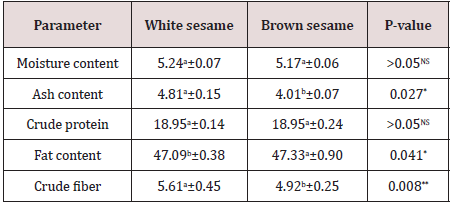
Values are mean±SD.Means having different superscripts are significantly difference at (P≤0.05).
Appendix 1:
Appendix 2:
Conclusion
Conclusion
When analytically investigated the differences in proximate composition of white sesame and brown sesame, the most results showed different significant patterns between the white sesame and brown sesame seeds and moisture, Ash, fiber where higher in the white sesame than in brown sesame seeds while protein is equal to all of them, the fat is higher in brown sesame than in white sesame seeds. These can lead to recommendation the people to want nutrient feed with white sesame and more studies should be carried out to cover the proximate composition of Sudanese sesame oil under different environment and the exercise of all the result is added at the appendix.
References
- El Khier MKS, Ishag KEA, Yagoub AEA (2008) Chemical Composition and Oil Characteristics of Sesame Seed Cultivars Grown in Sudan. Research Journal of Agriculture and Biological Sciences 4(6): 761-766.
- Gandhi AP (2009) Simplified process for the production of sesame seed (Sesamumindicum L). butter and its nutritional profile. As J Food Ag-Ind 2(01): 24-27.
- Naturland (2002) Organic farming in the Tropics and Subtropics. Sesame.
- Kanu PJ, Kerui Z, Ming ZH, Haifeng Q, Kanu JB and et al., (2007) Sesame protein 11: Functional properties of sesame (Sesamumindicum L.) Protein isolate as influenced by PH, temperature, time, and ratio of flour to water during its production. Asian Journal of Biochemistry 2: 289-301.
- Nzikou JM, Mato sL, Bouanga-Kalou G, Ndangui CB, Pambou-Tobi NPG, and et al., (2009) Chemical Composition on the Seeds and Oil of Sesame (Sesamumindicum L.) Grown in Congo-Brazzaville. Advance Journal of Food Science and Technology 1(1): 6-11.
- Loumouamou B, Silou TH, Desobry S (2010) Characterization of Seeds and Oil of Sesame (Sesamumindicum L.) and the Kinetics of Degradation of the Oil During Heating. Research Journal of Applied Sciences Engineering and Technology 2(3): 227- 232.
- Elleuch M, Besbes S, Roiseux O, Blecker C, Attia H (2007) Quality characteristics of sesame seeds and by-products. Food Chemistry 103 (2): 641- 650.
- Borchani C, Besbes S, Blecker CH, Attia H (2010) Chemical Characteristics and Oxidative Stability of Sesame Seed, Sesame Paste, and Olive Oils. Journal of Agriculture, Science and. Technology 12: 585-596.
- Ogunlade I, Ilugbiyin A, Osasona AI (2011) A comparative study of proximate composition, anti-nutrient composition, and functional properties of Pachiraglabra and Afzelia Africana seed flours. African J Food Sci 5(1): 32-35.
- AOAC (2005) Official methods of analysis of the association of analytical chemistry international, 18 (edn). Gaithersburg, MD USA Official method 2005.08.
- Özcan M, Akgül A (1995) Some compositional characteristics of sesame seed and oil. J Agr Forest 19: 59-65.
- Dashak DA, Fali CN (1993) Chemical composition of four varieties of Nigerian bennised (sesamumindicum). Food Chem 47: 253-255.
- Bennet M (2011) Sesame seed: A Handbook for Farmers and Investors.
- Paganuzzi V, Leoni E (1979) The composition of ranianolive oil. J Am Oil Chem Soc 56: 925-930.
- Gomes MSO, Sinnecker P , Tanaka RT, L anfer-Marquez UL (2003) Food chem J Agric 51: 1634-1639.
- Omar JMA (2002) Effects of feeding different levels of sesame oil cake on performance and digestibility of Awassi lambs. Small ruminant research 46(2-3): 187- 190.

Top Editors
-

Mark E Smith
Bio chemistry
University of Texas Medical Branch, USA -

Lawrence A Presley
Department of Criminal Justice
Liberty University, USA -

Thomas W Miller
Department of Psychiatry
University of Kentucky, USA -

Gjumrakch Aliev
Department of Medicine
Gally International Biomedical Research & Consulting LLC, USA -

Christopher Bryant
Department of Urbanisation and Agricultural
Montreal university, USA -

Robert William Frare
Oral & Maxillofacial Pathology
New York University, USA -

Rudolph Modesto Navari
Gastroenterology and Hepatology
University of Alabama, UK -

Andrew Hague
Department of Medicine
Universities of Bradford, UK -

George Gregory Buttigieg
Maltese College of Obstetrics and Gynaecology, Europe -

Chen-Hsiung Yeh
Oncology
Circulogene Theranostics, England -
.png)
Emilio Bucio-Carrillo
Radiation Chemistry
National University of Mexico, USA -
.jpg)
Casey J Grenier
Analytical Chemistry
Wentworth Institute of Technology, USA -
Hany Atalah
Minimally Invasive Surgery
Mercer University school of Medicine, USA -

Abu-Hussein Muhamad
Pediatric Dentistry
University of Athens , Greece

The annual scholar awards from Lupine Publishers honor a selected number Read More...





